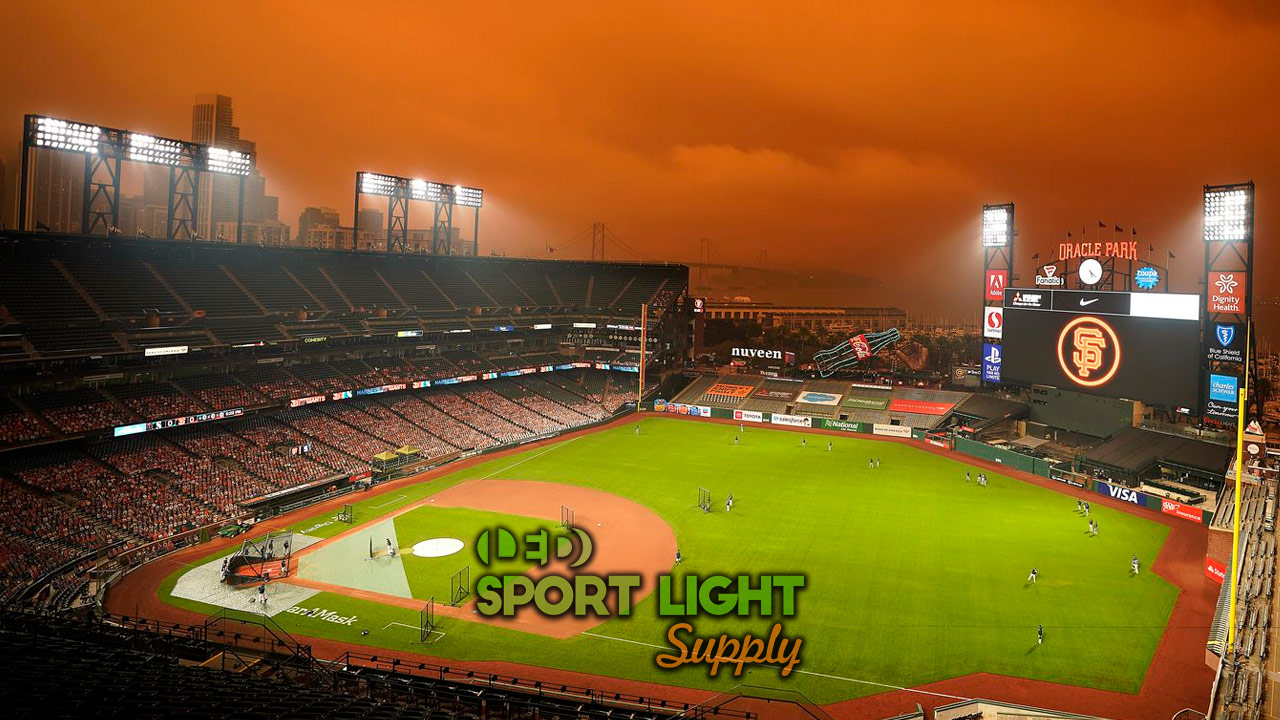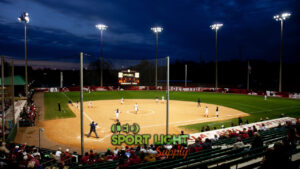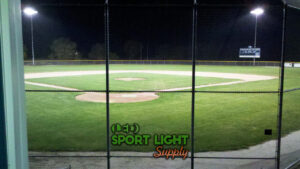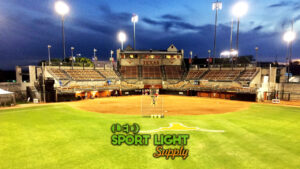Choosing the right LED lighting system for sports facilities or gyms is not easy. In fact, on the one hand, a standardized brightness and shadowless areas are ideal for a stadium. At the same time, the baseball facility owner would like to reduce energy consumption. Both in economic and environmental terms.
The best solution is to rely on a variety of LED lamps on the market. They not only offer proper lighting for the baseball and softball field but also help to save on your electricity bill.
Here is an extensive guide on the ideal lighting layout. In detail, you are going to read everything that matters, from the national standard to the insider tips, secrets, and tricks.
What lights are used in the baseball field and softball stadium?
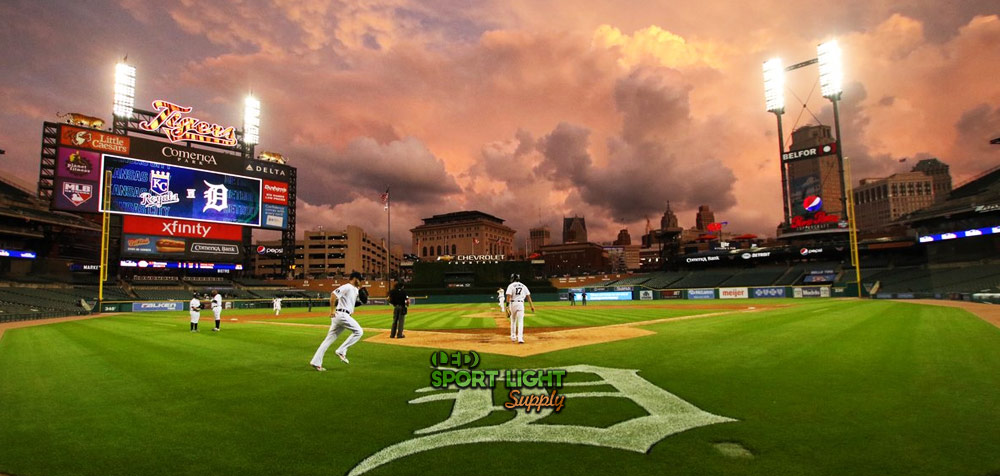
To start with the first question, understanding the available light fixtures types is necessary. You may have to replace or choose better light fittings from time to time. So, naming them is the first step to approach the whole subject.
What are the names of baseball stadium lights? In baseball and softball ballparks, you will find high power flood lights and spot lights. Usually, the regional and national lighting standard requires high mast lighting. Today’s light fixtures use LED lamps. But you can still find older metal halide or halogen models.
Let us get to know each of them more in detail.
1. High power flood lights
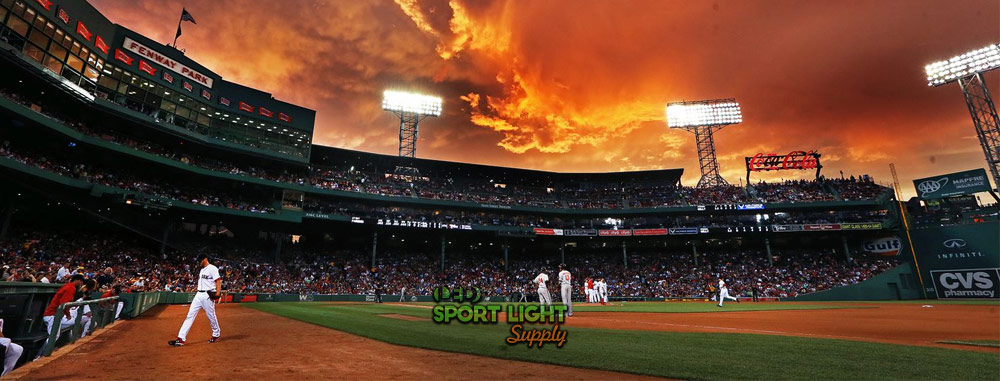
High power flood lights are an excellent solution for lighting up short-range areas. Especially the infield. These fixtures have a large beam angle and distribute the light evenly.
Most flood lights with high-tech LED sources offer excellent lighting performance combined with a high color rendering index (CRI). Moreover, you can install them on any mounting bracket or support. Plus, you can use them in groups. But you still need to be aware of the overall weight to safely put them at great heights.
The integrated design hosts the LED modules, the heatsink, and the shielding. Notably, it creates a uniform light ideal for illuminating the baseball facility.
2. High power spot lights
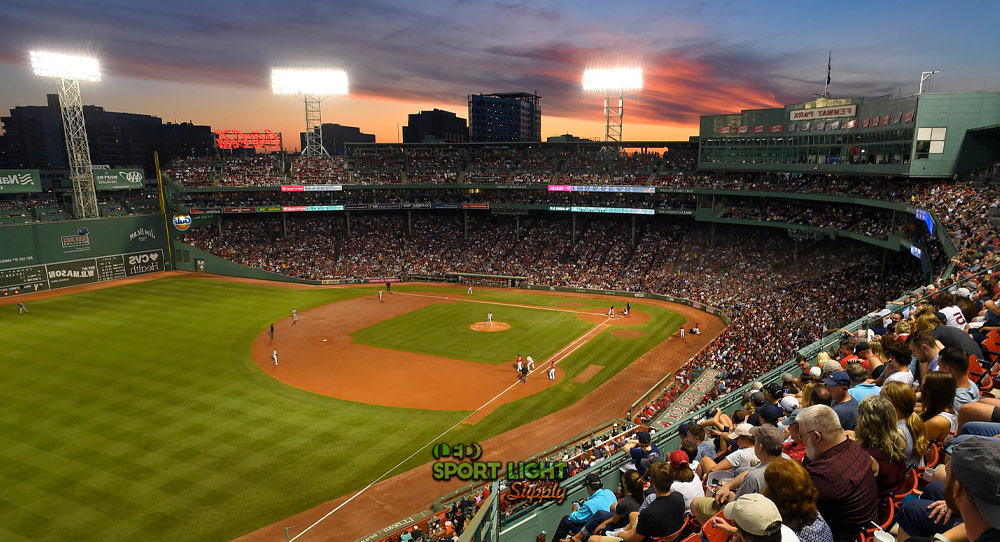
High power spot lights offer a small beam angle for long-range lighting. Think illuminating the outfield as one of the nine outfielders jumps to catch the ball. As you know, the outfield stretches for many feet, so it requires an even light distribution.
The spot lights give you the advantage of being adjustable. In brief, you can use them to direct the light towards specific points in the baseball or softball field. They are perfect for highlighting some details or brightening weakly lit areas. A single spotlight is suitable for illuminating a particular player or the pitcher’s mound. A bracket with two, three, or more spot lights can also work well as a main light.
3. High mast lighting
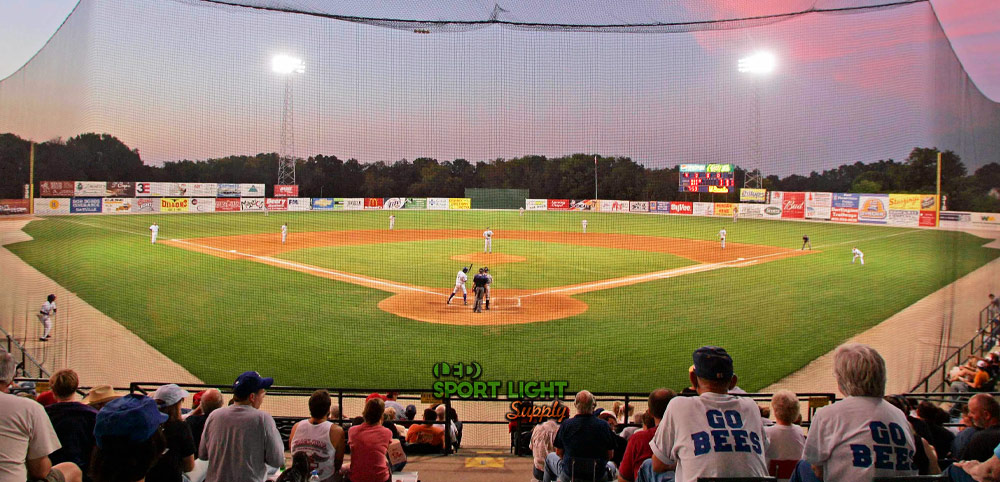
The light generated by a light source must reach the target from great heights to make objects and surfaces visible. Only then will the light be partially reflected towards the observer’s eye, thus engaging the vision process.
Any beam of light that does not follow this path is useless. On the other hand, if it arrives directly from the light source into the pupil, it becomes a cause of glare. In practice, only the light that reflects from the area you want to make visible is functional for the purpose of illuminating.
High mast lighting provides the best solution to place light fixtures in such a way as to create a comfortable vision.
Outdoor baseball field lighting layout
The Little and Major League lighting standards require you to achieve precise light levels. As you might guess, it all starts with high mast positioning. More precisely, three questions arise almost immediately:
- How many light poles are necessary?
- Where to put each pole for the best results?
- What is the recommended pole height?
Here are the answers to these basic questions about a standard outdoor baseball field lighting layout. But remember to read the current specification for your level of play in case changes take place. You also need to assemble, operate, and do the regular maintenance of the lighting masts. To do that, follow the manufacturer’s instructions.
1. How many light poles do we need for the baseball and softball field?
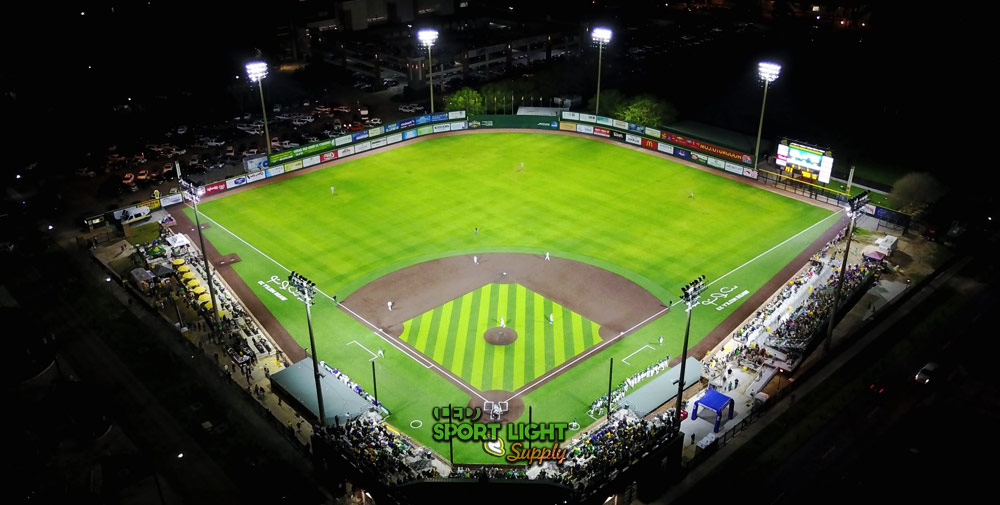
The most prevalent designs involve the use of a 4-, 6-, or 8-pole layout. At least 2 poles are responsible for infield lighting. Instead, 4 to 6 poles provide illumination for the outfield.
The size of the baseball diamond determines the total number. More specifically, the ballpark radius is the critical factor. If the field radius is between 200 and 250 feet, then a 4-pole layout would do just fine. But most Little League baseball fields extend to up 300 feet. In this case, you need at least 6 light poles.
A bigger Major League baseball (MLB) facility would use an 8-pole layout. If nothing else, to meet the lighting standards for television broadcasts.
2. Where are the baseball field light poles – the placement guide
Basically, you need to place the light pole around the perimeter of the outfield. However, each placement must follow a strict lighting design. For example, the pole location can vary by several feet from an ideal installation point. Nonetheless, each baseball field light pole must be located in a specific area of destination.
The lighting engineer will plan a layout for the installation of the lights. In detail, you should see a shaded area for each pole in the documentation. The first two poles go behind the home plate to provide illuminance for the batter’s box and the infield. For the best results, the imaginary lines that start from the first two poles to the home plate should cross at a right angle.
Then, the third and fourth poles will be approx. 140 to 170 feet from the point of origin of the field radius. And at least 40 feet behind the outfield fence in a stadium field. Their main function is to illuminate the outfield.
In a 6- and 8-pole layout, the remaining light poles are located outside the baseball ballpark fence. Roughly, at 20 degrees location from both sides. Or respectively at 10 and 30 degrees on each side for the 8-poles layout.
In short, the lighting bodies that lights up the infield must be inclined to a 25-degree vertical angle. Every LED light that illuminates the outfield must have a 21 degrees minimum vertical angle.
3. Light pole height
Of course, different manufacturers can have varying prepared solutions. But, you might have to meet a particular requirement before you can use the baseball facility for some sports events. Notably, the most common light pole height standards:
- Training/recreational use: 39 to 49 feet (12 to 15 meters)
- High School/College standard: 49 to 65 feet (15 to 20 meters)
- MLB: 82 to 196 feet (25 to 60 meters)
The height difference is due to the horizontal and vertical illuminance standards. Thanks to a series of calculation, the lighting designer ensure the correct amount on the playing area. Also, different heights and vertical angles are required to prevent spill light.
Indoor baseball field lighting layout
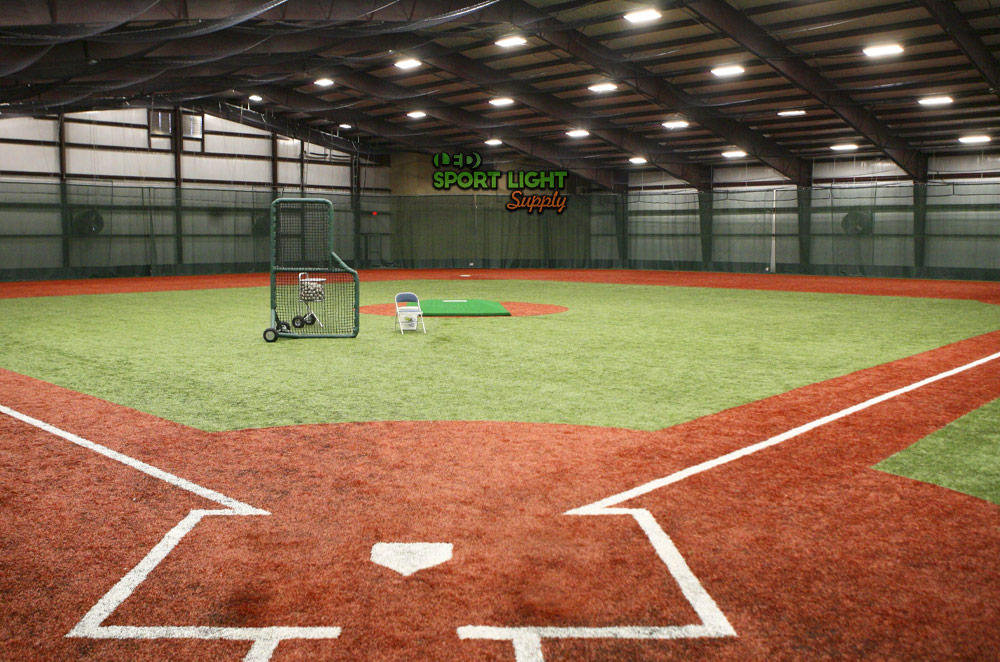
You can place the conventional baseball field inside a combined baseball-softball facility. As well as the indoor batting cage used for training. So, the indoor batting cage lighting layout must adjust to the many indoor arenas variations.
Among the several factors at play that you now need to consider, here are the primary ones:
- Ceiling height
- Ceiling type
- Field Size
- Spacing between the flood lights
- Distance between the lights and the wall
- Number of indoor batting cage lights
Here is what you need to know to meet the indoor lighting standard relevant to the various levels of play.
1. Ceiling height
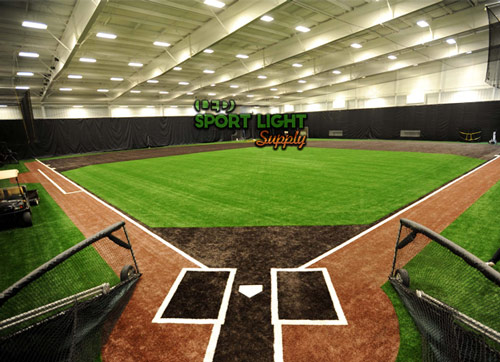 Mainly, the ceiling height will determine how many high bay UFO lights you will need to install. At the planning stage, the ceiling height is also going to influence the fixture wattages. So, you might opt for a dedicated electrical installation.
Mainly, the ceiling height will determine how many high bay UFO lights you will need to install. At the planning stage, the ceiling height is also going to influence the fixture wattages. So, you might opt for a dedicated electrical installation.
On the positive side, a ceiling allows increasing the number of lighting fixtures as needed. The use of protective nets could also be necessary to prevent damage to the lights.
Indoor athletic facilities should have a clearance of at least 60 feet from the ground up to the ceiling for softball activities. For this reason, the use of batting cages requires additional lighting.
2. Ceiling type
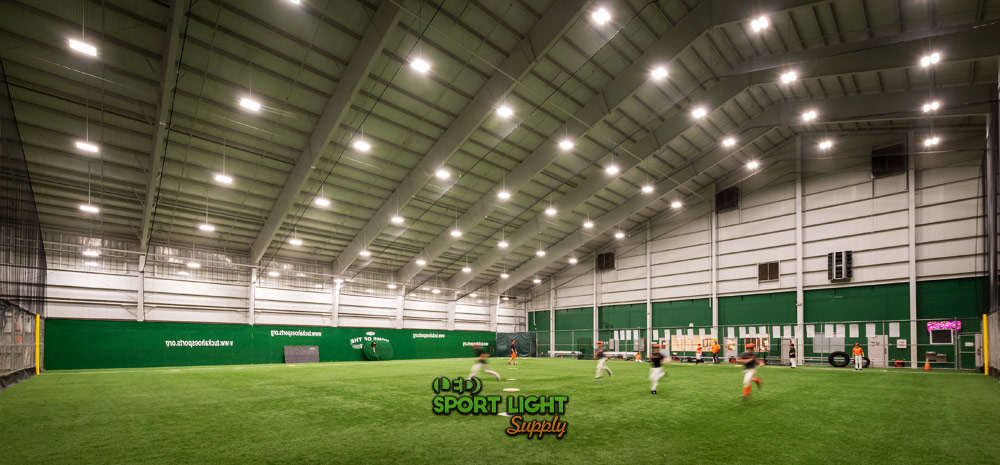
It is not unusual for a sports center to have a curved ceiling. In fact, the typical high school gym has one too. While the curved shape may induce a sense of open space, the lighting design calls for an adjustment.
Today, most indoor softball facilities have a flat ceiling. No matter the shape, the light fixtures still need to be suspended or installed in proper ceiling mounts.
The addition of a standard monorail system could further increase the number of luminaires. In detail, this solution is ideal for distant spot lights.
Of course, whatever ceiling type you have, you still need to meet the indoor values for standardized illuminance.
3. Field Size
The high school representative or domed stadium owner might want to increase the size of the baseball ballpark over time. For example, adding ten feet to the base path distance for a Little League field.
The field size changes the variables at play. In other words, changing the size also means new audits to maintain the lighting standards.
As I hinted at before, the field radius determines the field size. To specify, a turf softball field can take up to 30,000 square feet (or more) of floor space. Of course, this number does not include the training areas such as the batting cage.
4. Spacing between the flood lights
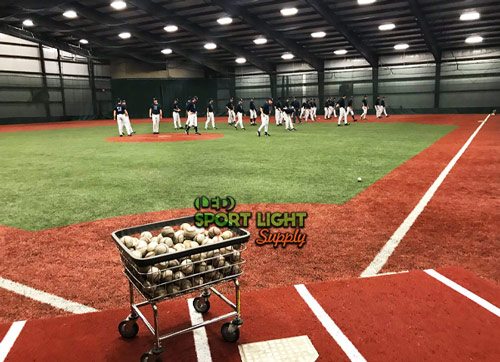 The horizontal distance between each LED flood light serves to ensure light uniformity. Mostly, the spacing depends on how many light sources you use. But even this factor relies on the lumen output of each lamp. In fact, you adjust the number of light fixtures installed by meeting the requested lux level.
The horizontal distance between each LED flood light serves to ensure light uniformity. Mostly, the spacing depends on how many light sources you use. But even this factor relies on the lumen output of each lamp. In fact, you adjust the number of light fixtures installed by meeting the requested lux level.
If the lighting manufacturer provided you a space height ratio (SHR) for your lamps, then you can calculate the spacing with a formula. Just multiply SHR by the mounting height.
The indoor lighting layout uses the same principles of outdoor baseball field lighting. But you can use a ceiling to mount high bay UFO lights and provide perpendicular lighting. So, you should aim to optimize the distance between each fixture.
5. Distance between the lights and the wall
As the ceiling height increases, the distance between the lights and the wall also increases. You could consider the angle of the artificial light beam for pleasant luminance contrast. If the light hits the walls at a 30-degree angle, it should be fine.
Usually, you calculate this distance by dividing the distance between each light in half. Once you know the spacing between each flood light, you half that number to get a rough approximation of where to put the fixtures.
Of course, this does not always apply to monorail lighting for spot lights used to provide specific lighting in long-range areas.
6. Number of indoor batting cage lights
Depending on how many batting cages you have, you will need more lights. As a matter of fact, at least two flood lights are necessary to illuminate a batting cage.
If you have multiple adjacent batting cages, you still need to provide the standard lux level. That is, the light level varies with the level of play.
For a baseball club, high school, or college facility, the minimum lux standard is 400 lux. So, the total number of indoor batting cage lights can increase to achieve the necessary light distribution. Even more so for a televised stadium where the minimum lux level is 700 lux.
Baseball / Softball field lighting design and standard
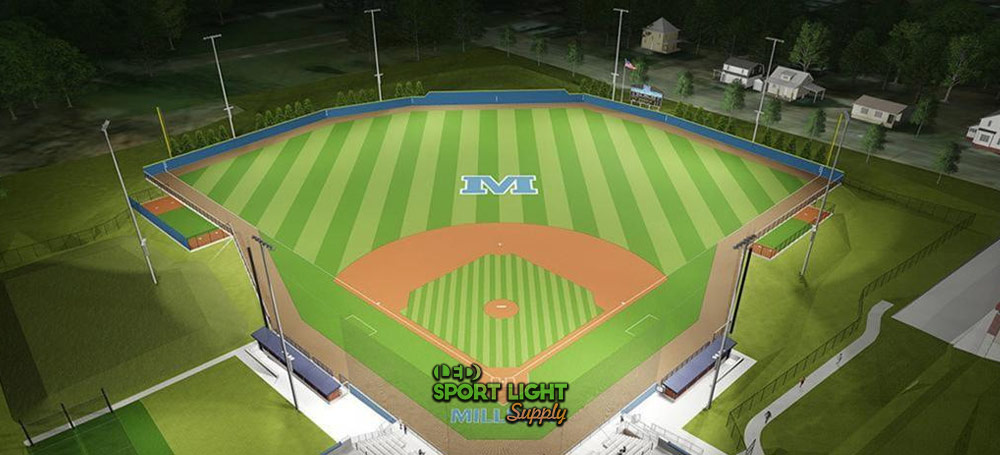
Little League and MLB’s rules request you to comply with several baseball lighting standards. So, it is better to tackle the general requirements for both indoor and outdoor activities at once.
First, you will read about the standards that apply both to indoor and outdoor fields. Lux levels and other tech specifications will be discussed. Then, we will focus more on the outdoor and indoor venue designs, one at a time. This includes the light pollution problem for residential areas and the heat dissipation issue in closed arenas.
General parameters (applicable for both outdoor and indoor baseball facility)
1. Lux required
Lux is a unit of measurement to quantify the light intensity of a light source. In short, a lux is a beam emitted by a lit candle, positioned at a distance of one meter within a space measuring 1 meter by 1 meter. But how do you measure a lux level? With a lux meter. That is, a device that gives you a precise reading.
Here are the required lux readings for:
- Training or recreational: 200 to 300lux outfield; 400 to 600lux infield.
- College or high school: 500 to 700lux outfield; 800 to 1000lux infield.
- Professional, MLB, international tournaments: 800 to 1000lux outfield; 1500 to 2000 lux infield.
2. Lighting uniformity
An even (or homogeneous) light distribution is a key feature of high-quality flood lights. But lighting uniformity is also a chief lighting standard. Mostly because it helps ballplayers detect and avoid obstacles in the ballpark and batting cages.
If the light distribution is uneven, holes or other hidden hazards can pose safety threats. It only takes a moment for baseball players to not be able to avoid an obstacle and injure themselves. So, the baseball and softball diamond must be evenly lit from every side.
First, you need to sample every square of the lighting design grid to record the minimum and maximum lux readings. Then, you calculate the average lux value. You can now divide the minimum and the average lux values to get the lighting uniformity value. Here are the design specifications for:
- Training: 0.4 to 0.6
- High school: 0.5 to 0.6
- MLB/international tournaments: 0.5 to 0.7
3. Color temperature
To begin with, we can divide the artificial light into warm or cold light. Warm light tends to yellow and cold light tends to blue.
The hue or color temperature of light is measured in degrees Kelvin (K).
In detail, you find the Kelvin values on the labels of most LED bulbs. You can get a more precise idea of what color temperature you get in this way: the higher the Kelvin value, the colder the light will be.
The four main color temperatures are:
- Warm light (2500-300 K)
- Warm white (3000-3500 K)
- Neutral white or natural daylight effect (5000-5500 K)
- Cool white (5500-6500 K)
4. Flicker-free lights
If you record a video in a room with artificial lighting, you can end up noticing a flicker in the video. In fact, video cameras pick up the standard flickering of LED lights. You will not get the same results with incandescence or other types of lamps.
Of course, flickering is a serious problem when it comes to televised events. For broadcasting baseball under LED lighting, you need flicker-free lights.
This feature shows up in the product specifications. If it does not, you should ask the manufacturer before buying any LED product for high school sports facilities or a stadium.
5. CRI and TLCI
When you look at any object that does not emit its own light, you can see its color because it reflects light. Your eyes absorb all the wavelengths of visible light.
Therefore, colors can change depending on the type of light source that illuminates them. Of course, many lamps try to replicate natural light for the best results. So, you can count on the CRI (Color Rendering Index) value for evaluating the quality of the light source.
Usually, LED lights have a CRI rating between 80 and 95, which is not bad. But for broadcasting purposes, the TLCI values give you a more precise quality rating. A TLCI rating of 90 or higher tells you that the light source is suitable for broadcasting.
Outdoor lighting design for the baseball diamond
1. Light pollution
The lighting layout must take environmental light control into consideration. In brief, spill light can cause glare or discomfort. Especially to anyone in the nearby residential or commercial properties. Moreover, light pollution can hinder the drivers’ vision and visual acuity.
Countermeasures are necessary to prevent or limit light pollution. For example, shielding the LED light fixtures. Plus, installing them on high masts at the correct vertical angle.
A proper lighting design must consider the type of lamps used in the stadium or sports facility. In detail, LED lights cause less light pollution than other types. But their higher intensity can cause glare.
2. The flood light angle of projection
The projection distance and the target area will determine the flood light angle of projection. Generally speaking, high mast flood lights have a 25-degree vertical angle when they need to light the infield. Any light fixture that illuminates the outfield should have a 21-degree vertical angle.
High power flood lights can illuminate distant and wide areas. But vertical illuminance is critical to make the baseball visible when it is in the air. Think of a fly ball. Both the catcher’s vision and the runners rely on a suitable angle of projection for vertical illuminance.
3. Lightning protection for high mast lighting
When building the light poles, lighting protection is essential. In short, the manufacturer must follow the NFPA 780 standard. Safety practices include:
- the use of conductors
- precise placing and separation of the ground rods
- additional protection from voltage spikes thanks to a surge protector.
The main goal is to protect the baseball or softball stadium’s electrical system. As a result, lighting protection cuts downtime and turnaround repair time. Of course, more protective devices are available to better isolate the LED flood lights. You can also prevent load switching and other common issues.
4. Waterproof rating of the flood lights
Outdoor LED flood and spot lights are exposed to the weather. So, most models are equipped with sealed gaskets to protect the electrical housing. In effect, an IP rating in the product specifications gives you an idea of the level of sealing effectiveness of each lamp.
The IP rating is a code made of two digits. The first digit relates to physical objects. Mostly, LED fixtures have an IP rating that starts with the number 6. That is, tightness sealing against dust.
The second digit relates to humidity resistance. For example, 1 is weak water resistance. On the other hand, a 6 means that the fixture can stand a high-pressure jet.
High-quality LED light fixtures are IP 67 or 68. That is, they are designed to work even when fully immersed, up to half an hour.
Indoor lighting design for baseball facilities
1. Ceiling height
This vade mecum would not be complete if I did not point out that:
- A low ceiling requires a large beam angle.
- A high ceiling needs a small beam angle.
So, if the indoor baseball facility has a curved or sloped ceiling, you need to use a smaller beam angle. In detail, a narrow spot light at the ceiling center (in a higher position) and at least one wider beam angle at the edge (in a lower location).
The use of mounting brackets or frames can also create the necessary space for a standardized lighting design.
2. Direct or indirect lighting
You can find both downward (direct) or upward (indirect) aiming arrays of lighting fixtures. The choice of one lighting layout or another has pros and cons.
Direct lighting offers more lighting uniformity. As you can imagine, this design optimizes light distribution at its fullest potential. But, it could also cause glare. So, here is why you could opt for an indirect system design.
Remember that:
- Direct means the lights point to the floor directly.
- Indirect means the lights point to the reflective ceiling. Basically, you use the reflected light to illuminate the baseball facility.
3. Heat dissipation
The longer a light source stays on, the more it can overheat. More precisely, the reflector might heat up till all sorts of issues appear. For example, a decrease in light efficiency. That is, a shortening of the life span.
The life span of LED lights will decrease significantly if the lights get too hot. Then again, you have to consider air circulation inside the building. As the hot air is easily trapped indoors, you need to select the lights. This means choosing lights with a good heat dissipation system. A mechanical ventilation heat recovery system can also help.
Should you buy used baseball field lights for sale?
You could be surprised to know that there is no definite answer to this question. As a matter of fact, you could get a great deal or buy softball field lights that do not last.
Most likely, a better answer would center around the most common advantages and disadvantages. You are going to read the most discussed stances for both considering or refuting buying sports lights for sale.
But first, let us discuss what used baseball diamond lights are and why would you even consider their pros and cons.
1. What are used baseball field lights?
As the name implies, they are second hand LED lights. Mainly, they have been used as baseball field lights and are available because of many reasons. For example:
- reconstruction of a baseball field
- close down of baseball field club/business
- upgrade to better, high-tech light fixtures
The main concern about used baseball field lights is whether they are safe to buy or not. However, you can come up with all sorts of ideas and request to evaluate a used product before you buy it. As a rule of thumb, when in doubt, ask the seller for the product specification for your own testing.
2. Advantages of buying used baseball field
a) Baseball field lights at a discounted price
Let us start with the obvious fact: these baseball field lights are on sale. You can buy stadium lights at a very cheap rate. In short, they are suitable for a tight-budget baseball stadium owner.
As you might know, baseball stadium lights are built to last. So, there are good chances that they will prove to be a cost-competitive choice.
The price can drastically go down on more complex fixtures. Of course, you might have to replace some LED flood lights. But on balance, the whole package contains more fixtures that will make you save big money.
b) Instant availability
When you place the order, you know for a fact that these lights are instantly available. That is, no need to wait for manufacturing.
When you buy new lights, it may take 15 to 60 days for a manufacturer to prepare and ship the LED lights. But, when you buy used baseball or softball lights, the owner has already packaged them.
Sometimes, you can even save on the installation costs. In fact, some reselling companies may provide a great deal, which includes the installation in sports venues within a certain area.
3. Disadvantages of used baseball field lights
a) Lack of customization
Your ballpark may require a specific set of light fixtures. Maybe, you need varying lumen outputs or beam angles. After all, different baseball fields have various field sizes, light pole layouts, high mast heights, etc.
By choosing used baseball field lights, problems may arise. For instance, the stadium could incur poor light uniformity and inadequate brightness. In this case, it is recommendable to buy new lights. We manufacturers can customize the lighting specifications. To give you an idea, custom modifications can include:
- a precise lumen output
- calibrated beam angles
- an exact color temperature
- pre-installed shielding and other accessories
b) Unknown lifespan
Above all, you do not know how many hours (life span) remain. The luminous efficiency of a LED light source is the ratio between the luminous flux and the current consumed.
The measure of efficiency is expressed in lumen/watt. But the luminous flux deteriorates over time due to continuous use and overheating. Of course, when the luminous efficiency goes down, other values drop as well. For example, the color rendering ability. A high CRI or TLCI rating could drop significantly with usage. So, you might find out that the used baseball stadium lights have indeed a shorter life span.
c) Warranty issue
Here is the reason why you need a reputable seller. Used baseball or softball field lights might be hard to repair. Maintenance could cost you a lot. Especially if the warranty period is expired.
Sometimes, you find dated or old light models on sale. Such a deal might be tempting, but in reality, it is a gamble. In fact, either the lights work flawlessly, or you will use them only till they stop working. That is, because fixing them would require too much time, money, or effort.
You also need to consider any retrofitting activity you might need to pay for when installing the old models.
How to select the best baseball field lighting companies?
Most people search for online reviews. But, online ratings will not tell you the whole story. A reliable baseball field lighting company must display a precise set of skills. For one thing, they must know their craft inside out.
A customer should find an answer to his or her questions because the company provides transparent data. Moreover, the price reflects the level of ability and expertise. At the very least, more than it serves to reel in new customers each time.
So, here are a few words on the most critical aspects of a competent baseball field lighting company.
1. Expertise
First of all, you should find out more about their past experiences. That is, whether or not they have any baseball field lighting knowledge. Who were their previous clients?
A proud sports lighting company will share with you some of their previous works. If nothing else, they would do it to let you know that you can trust them.
Modern sports lighting companies will go the extra mile and share with you their tech achievements. In fact, both lighting designers and engineers must continuously train to keep up to date with the latest innovation in the industry.
2. Price
Simply put, beware of cheap prices. The price should not be extremely low. For example, less than $0.4 per watts LED lights is a bogus price. Why? Because they are probably selling shoddy products.
There is no way that any company could cut the cost of producing LED lights. Much less cutting the transport or production costs of high-quality baseball field lights. It is clearly impossible. So, the logical explanation would be that they are either selling poorly made or reconditioned products.
Always ask for more detail and specifications related to cheap products. It might save you from semi-legal fraud.
3. Lighting design (Customization service)
In this industry, claiming to be an expert contractor is not enough. A reputable stadium lighting company must provide custom services. After all, their goal should be satisfying every customer’s needs.
Here is an example: you could contact us for a DIALux simulation service. We can accurately estimate the number of LED light, beam angle, power, etc. that you specifically need.
Not every company can do the same for their customers. Many companies sell packages only. But if the customer must spend more time to figure out how to use or install the product correctly, that should be a clear sign that something is not right.
4. R & D
Research and development are crucial factors both for the sports lighting company and their customers. Only in this way will they improve the lighting products from time to time.
Without continuous training and developing new lighting solutions, no lighting designer can grow. As a result, the customer should change the baseball lighting company regularly.
Often, these businesses are also LEDs suppliers for public bodies involved in the research field. For example, universities or private labs that experiment with the effects on people on behalf of third parties.
You should browse their website for more info about this topic or ask them directly.
5. Warranty
The presence of a sensible warranty is always welcomed. That is, a 5 to 10 years warranty, as most LED lights share such a reasonable life span range.
You should also avoid a warranty that is too short or too long. In fact, a too-short range, say 1 to 2 years, implies that the lights might not last long. On the other hand, a too-long span, like more than 30 years, suggests that they are probably lying.
Selling tactics are used all the time. Especially before the baseball season starts, when stadium owners need to gear up.
6. Customer service
Nothing represents high-quality service more than a company’s customer service. In fact, it is so relevant that you should put it to the test even before you place an order.
Evaluate their response time, whether or not they can solve your issue, or what solutions they can suggest. The choice of competent customer service staff members can reveal the nature of a lighting company.
If you send them an email asking for something, but they reply with a different answer, how can you trust them? Communication is the basis for any smooth transaction. But more importantly, for the customer’s satisfaction.
Baseball field lighting FAQ
1. How much does it cost to buy baseball field lights?
You can expect to shell out from $10,000 to $120,000. Mainly, the baseball stadium lighting cost depends on the level of competition, field size, light pole layout, height, and other tech specs.
The standard indoor softball facility may use more lights for multi-purpose pitches. Alternatively, you could consider secondary lighting devices, such as movable light towers.
Then again, you might need to buy lights for the adjacent baseball batting cage. In the end, you are better off requesting a complete and detailed quote to get a transparent price per unit.
2. How much does it cost to run the baseball and softball stadium lighting?
The type of light fixtures will determine how much power they drain. Roughly, you will spend from $6 to $60 per 10,000W per hour. Luckily, you can cut the electricity bill by using LED lights.
Here is a practical example. Let us suppose you need to light up a baseball field that needs a total of 50,000 Watt LED lights. If you were to use metal halide lights instead of LED, you would consume between 150,000 and 250,000 Watts to generate the same brightness. Similarly, halogen lamps can eat up 500,000W to achieve the equivalent LED brightness level. So, it is really up to what you install. Using LED can save running costs big time.
3. What is baseball field lighting grants or funding?
Baseball field renovations may benefit from national and international funding. Any baseball club or association can usually apply for a grant. A foundation or local committee usually writes out the eligibility criteria.
An NGO may request free lighting design and/or lighting supply to its baseball facility. It is similar to regular sponsorship. But it all comes down to each specific funding programme.
Some funding agencies might not support operating expenses, salaries, or marketing costs. The baseball facility owner should read the terms carefully for the best use in strategic planning.
More on public financing of professional baseball stadiums
Some governments provide funding to upgrade the energy-efficient lighting in local baseball facilities.
Usually, public financing relies on a budget office to select valuable initiatives and requests. Often, the budget process follows a strict course of action. But you cannot foresee curtailing these funding programmes due to political pressures.
Your best bet is to prepare a modular funding project. In detail, this means you create a modular lighting design. That is, you buy necessary equipment in blocks and install them shortly afterward.
Remember that the fiscal norms do not depend on the public body. At least, most of the time. You are still liable for any judicial and fiscal duty.
4. How to select the best baseball field lights?
Here is a short guide to help you find the most suitable lights for your baseball facility. Maybe, you want to upgrade outdated high-intensity discharge lamps or add more high masts.
You can get back to this section anytime you need a quick answer for the best baseball field lights. This info is up to date, on point, and suitable for any ballpark. It is also a shortcut for the best lighting layout if you are still at the planning stage.
a) Luminous efficacy
You need great lumens per watt ratio to illuminate a baseball stadium. On average, the better the product, the less the light loss.
Poor product design means high power consumption, dispersion, and harmful heat production. All this translates into a waste of energy, money, and environmental impact.
Clearly, the most performing tech is LED lighting. The luminous flux is the quantity of light generated by the source and is indicated in Lumen. In short, the goal is to get the highest lumen output per watt.
b) Beam angle
Make sure you select the correct beam angle when choosing the baseball field lights. Usually, you need more wide-angle flood lights than narrow angle spot lights. But it all depends on what support you use for the installation of the lighting system.
Most high bay UFO lights for softball activities have a wide-angle. However, you can customize different lights for varying purposes. Always consult with a lighting designer to find the most suitable light layout.
c) Color temperature
Most ballplayers prefer natural or slightly cool light. Excessive warm light should be avoided at all costs. Usually, batters find a natural daylight color temperature (5,500 K) to be optimal for training in the batting cage.
Color perception can influence some players’ performance. If you are a baseball coach, keep track of usage for the best results. In most lighting control systems, you can adjust the color temperature according to the hours of the day or weather.
d) Life span
LED lights are known as light sources with the highest life span. With this in mind, the decay of the luminous flux is inversely proportional to the increase of temperature in the junction point. That is, the point where the light fixture anode and cathode meet.
No other light fixture type transfers heat better than LED lights. In detail, the light emitting diodes are more efficient than other materials. So, a heat sink can absorb the excessive heat, keeping the lamp cool.
A light sensor is useful to further improve the life span of baseball stadium LED lights. Also known as dusk to dawn function, these sensors can activate the lights only when necessary.
e) Flicker-free
If broadcasters are going to stream or record the game on the playing area, you need flicker-free lights. Be sure to look for specific badges and certifications before placing your order.
In any case, ask the customer service if the warranty covers any problem related to this feature. Usually, it does. But, in case they do not accept returns, you need to reconsider how you are going to deal with that contractor.
When dealing with resellers, contacting the manufacturer can also prove to be effective. Make sure to get the exact serial number to request the full specifications.
f) Glare
Always aim at low to moderate glare under the plane of the luminaries pointing downward. Also, horizontal uniformity must not hinder the baseball or softball players. When designing the ballpark layout, you should take care of the spectators in the stand as well.
Pole height is maybe the most critical factor when it comes to glare. Once the stadium lighting is installed and operative, it might be hard to mitigate this issue.
If light control fails, install shielding and accessories to minimize the glare problem.
g) Warranty
As previously mentioned, get a 5 to 10 warranty for baseball and softball facilities LED lights. After that, make sure that the qualified tech staff possesses the requisites envisaged by the applicable regulations.
When installing the light fixtures, you need actual documentation. Especially if you manage a high school or college sports facility. The work should conform with the Little League or Major Baseball League requirement. Or with any and every lighting standard you are going to comply with to host official sports events.
Conclusion
Setting up the baseball field and softball field lighting can be a daunting process. This guide streamlined the most basic and advanced concepts. Or rather every norm applicable to the typical baseball facility.
You should now be more confident about purchasing stadium LED lights as well. You know have all the info it takes to illuminate the baseball diamond properly. Moreover, you can better focus on any secondary rule and requirement, knowing what the primary standards are.

